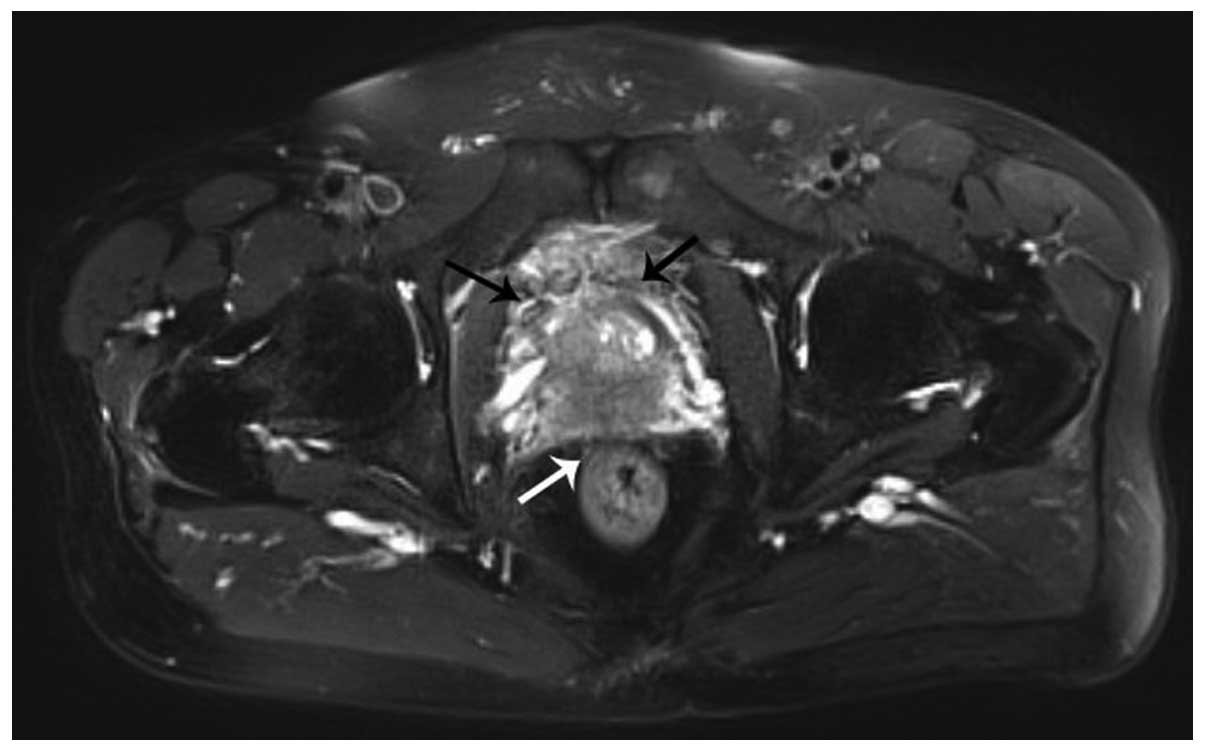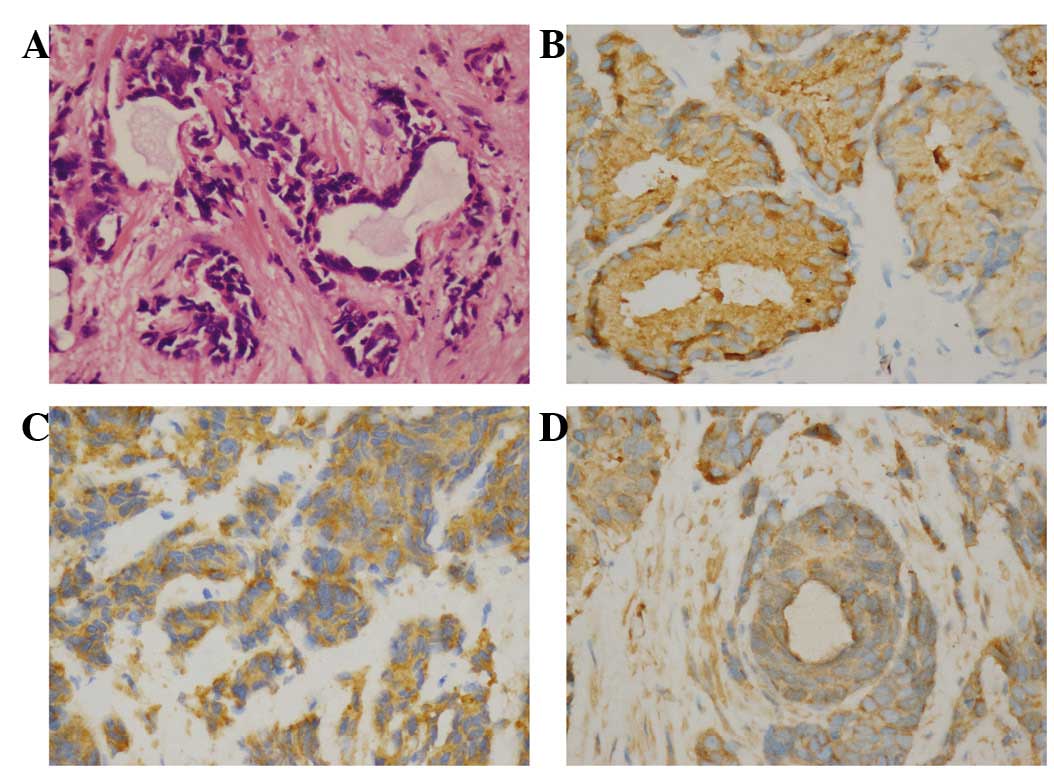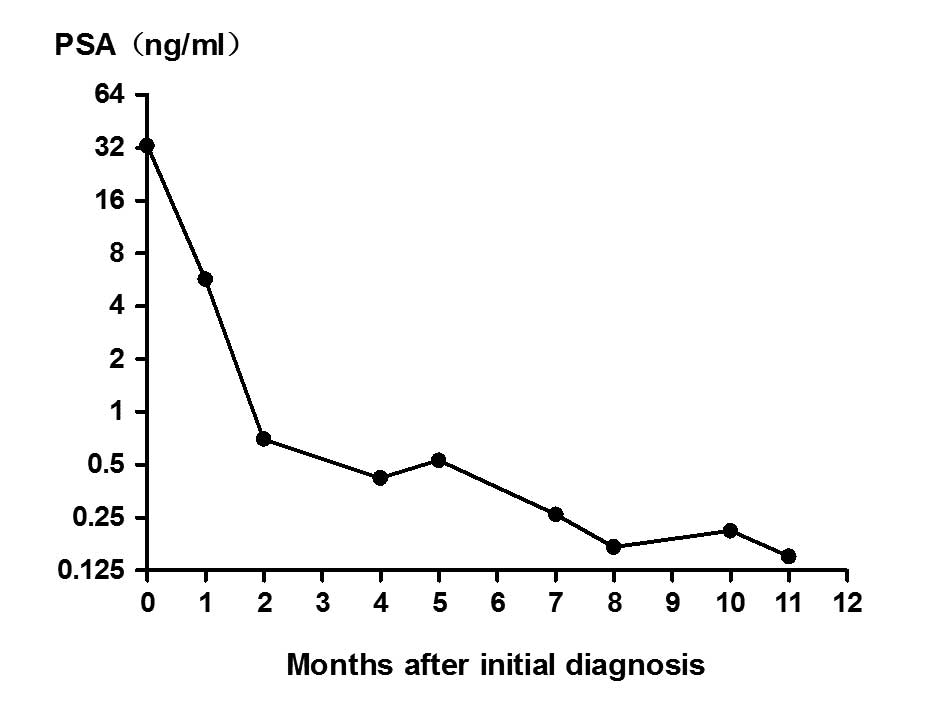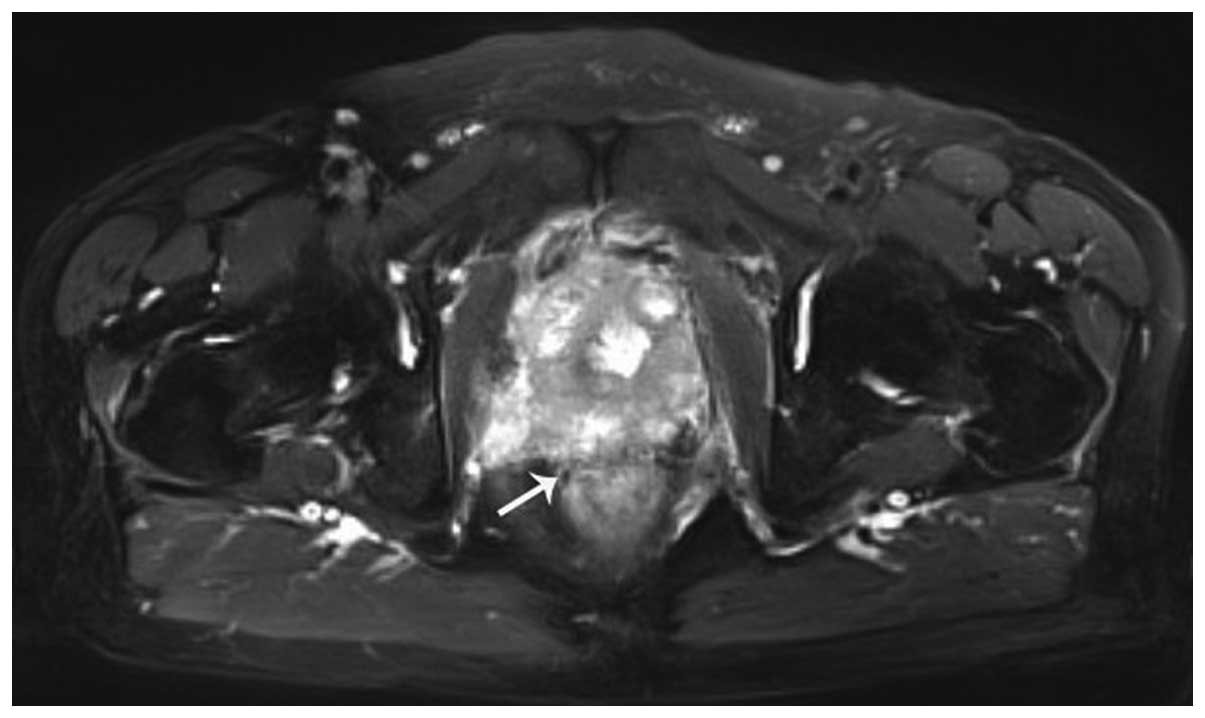Rapid progression of mixed neuroendocrine carcinoma‑acinar adenocarcinoma of the prostate: A case report
- Authors:
- Published online on: June 16, 2016 https://doi.org/10.3892/ol.2016.4737
- Pages: 1019-1022
Abstract
Introduction
Pure primary neuroendocrine (NE) prostate cancer (NEPC) is a rare entity (<1%) with an incidence of 35 cases per 10,000 individuals each year (1). The majority of NEPCs originate from conventional prostatic adenocarcinoma, and mixed NE carcinoma-acinar adenocarcinomas of the prostate are formed (2). Marcus et al (3) identified 502 cases of NE carcinoma and this study showed that the 5-year overall survival of NE carcinoma was 12.6% while the 5-year overall survival for non-variant prostate adenocarcinoma was 76.5%. More than one-half of patients presented with metastatic disease at diagnosis and the prognosis of NEPCs was poor. A combination of platinum plus etoposide may be helpful. However, the duration of response was transient (1). Fléchon et al (4) studied carboplatin and etoposide administration in patients with anaplastic progressive metastatic castration-resistant prostate cancer with NE differentiation. The treatment combined carboplatin, with a target area under the plasma concentration versus time curve of 4, administered over 1 h on day 1, and etoposide at a dose of 100 mg/m2 per day administered intravenously over 2 h for 3 consecutive days. This regimen was repeated every 21 days, with a maximum of 6 cycles. Of 41 patients treated, 13 (33%) obtained a serum NE marker response (>50% decrease of neuron specific enolase or chromogranin A). This study demonstrates that the association of etoposide and either cisplatin or carboplatin is active in poorly differentiated NE cancers (4). Another study performed by Fjällskog et al (5) also demonstrates that the combination of cisplatin and etoposide can produce significant responses in patients with heavily pretreated and poorly differentiated/rapidly progressing NE tumors. The present study reports a typical case of mixed NE carcinoma-acinar adenocarcinoma of the prostate. Patients with mixed NE carcinoma-acinar adenocarcinoma of the prostate have rarely been reported. The progression of this tumor is associated with aggressive disease, frequent visceral metastases and a poor prognosis (6). In the current study, the case of a 78-year-old male is presented. Mixed NE carcinoma-acinar adenocarcinoma of the prostate was confirmed by transrectal prostate biopsy due to a 12-month history of urinary frequency and urgency. The patient underwent transurethral resection of the prostate after 6 months of androgen-deprivation therapy for extraordinarily salient difficulty in urination. Invasion of the rectum appeared several months later. The neoplasm progressed extremely fast within a short time. The patient provided written informed consent for publication of this case study.
Case report
In October 2013, a 78-year-old male presented to the Department of Urology, The Third Xiangya Hospital of Central South University (Changsha, China) with a 12-month history of urinary frequency and urgency. The patient denied any difficulty of urination, gross hematuria, bone pain or significant weight loss. Digital rectal examination demonstrated an enlarged, firm prostate, with nodules. The remainder of the physical examination was unremarkable. The patient had no significant medical history other than type II diabetes mellitus. The serum prostate-specific antigen (PSA) level was 33 ng/ml, while the commonly used reference range of PSA is <4 ng/ml.. Magnetic resonance imaging of the pelvis disclosed the serious possibility of prostate cancer involving the bilateral seminal vesicle glands and urinary bladder, with no lymph node metastasis (Fig. 1). Bone scans via single photon emission computed tomography disclosed metabolic abnormalities on the upper segment of the left femoral bone. A 12-core transrectal ultrasound-guided prostate biopsy was performed.
Histopathology revealed mixed NE carcinoma-acinar adenocarcinoma (Fig. 2). Tissue samples were fixed in 4% paraformaldehyde, dehydrated in a graded ethanol series (70, 80, 95, 95, 100 and 100%) and paraffin-embedded. Tissue paraffin blocks were sliced into 2.5-µm sections after being frozen. Prostate cancer-associated protein markers were detected by hematoxylin-eosin staining and immunohistochemical staining. The antibodies used were as follows: Anti-prostatic acid phosphatase antibody (rabbit monoclonal; dilution, 1:250; catalog no., ab108984; Abcam, Cambridge, UK); anti-synaptophysin antibody (rabbit monoclonal; dilution, 1:400; catalog no., ab32127; Abcam); anti-chromogranin A antibody (rabbit polyclonal; dilution, 1:400; catalog no., ab15160; Abcam); and IgG secondary antibody (goat polyclonal; dilution, 1:100; catalog no. ab175471; Abcam). The hematoxylin-eosin staining revealed poorly differentiated acinar adenocarcinoma in certain areas of the prostate, while the immunohistochemical examination revealed that the tissue sections were positive for prostatic acid phosphatase, synaptophysin and chromogranin A, leading to the diagnosis of mixed NE carcinoma-acinar adenocarcinoma.
The patient was referred to a medical oncologist for therapy of clinical stage T4N0M1b prostate cancer, according to the prostate tumor-node-metastasis staging system of American Joint Committee on Cancer (7th edition) (7). Combined androgen blockade with bicalutamide and triptorelin was initiated (bicalutamide 50 mg daily and triptorelin 15 mg every 3 months, with a total course of 12 months). The patient's PSA level responded well, decreasing to 0.7 and 0.42 ng/ml after 2 and 5 months of treatment, respectively. Approximately 1 month later, and 6 months after the initial treatment, the patient presented with difficulty in urination and urinary frequency. The PSA level was rechecked and found to be 0.53 ng/ml (Fig. 3). Transrectal ultrasonography estimated the volume of the prostate to be larger than previously. A plasmakinetic resection of the prostate was performed. Combined chemotherapy based on etoposide and carboplatin was then initiated simultaneously with the endocrine therapy (etoposide 100 mg daily for 3 consecutive days, repeated every 4 weeks, and carboplatin injection 400 mg once, repeated every 4 weeks, with a total course of 6 months). The serum PSA remained at a low level (<0.5 ng/ml) from then on. Conversely, the patient's clinical discomfort progressed markedly (Fig. 4).
Approximately 5 months after the combined chemotherapy and endocrine therapy, the patient presented with acute urinary retention and underwent urethral dilatation. Subsequently, 12 months after the initial diagnosis, the patient's condition deteriorated. In addition to serious lower urinary tract symptoms, the patient presented with urinary tract infection and kidney failure, although the serum PSA remained at a low level (<0.7 ng/ml). Endocrine therapy was terminated and docetaxel (120 mg injection, every 4 weeks for 3 months) was used to replace etoposide and carboplatin. However, those measures had little effect on the patient's serious lower urinary tract symptoms. Finally, 18 months subsequent to the initial diagnosis, the patient succumbed to cachexia.
Discussion
The majority of conventional prostate cancers are prostatic adenocarcinomas, which are formed from tumor cells with luminal differentiation that express androgen receptors (ARs) and secrete PSA. Therefore, hormonal therapy based on AR-dependent signaling that results from AR gene amplification, constitutive activation of AR, intratumoral androgen production or other mechanisms is used in patients with prostatic adenocarcinoma at the time of initial diagnosis, and achieves a therapeutic effect in nearly all cases (8). Even castration-resistant prostate cancer shows progression via AR-dependent signaling mechanism (9). The patient in the present case experienced rapid progression following the diagnosis of mixed NE carcinoma-acinar adenocarcinoma of the prostate.
NE cells exist in normal prostate tissues, without expressing AR or secreting PSA. Extensive focal NE differentiation is present in 10% of all conventional adenocarcinomas (10). It has been proposed that androgen-deprivation therapy may facilitate progression of pre-existing prostatic adenocarcinoma to NE prostate cancer. A consequence of a lack of ARs is that deprivation hormonal therapy does not eliminate NE cells (11). This phenotype composed of aggressive and highly proliferative NE cells shows conspicuous clinical progression with a low serum PSA level. Kinebuchi et al (12) reported a case of relapsed prostate cancer with high serum levels of carcinoembryonic antigen and pro-gastrin-releasing peptide, without elevation of serum PSA after bicalutamide and leuprorelin acetate combined hormonal therapy for 39 months. The patient finally succumbed after a survival period of 11 months following the clinical progression. The present study patient underwent transurethral resection of the prostate due to difficulty in urination after receiving endocrine therapy for 6 months, and the pathological examination indicated mixed NE and prostatic adenocarcinoma once again.
The international classification standard for NE prostate cancer is not yet clear. According to the Prostate Cancer Foundation, the pathological classification system for prostatic cancer NE differentiation consists of the following: i) Usual prostate adenocarcinoma with NE differentiation; ii) adenocarcinoma with Paneth cell NE differentiation; iii) carcinoid tumors; iv) small cell carcinoma; v) large cell NE carcinoma; and vi) mixed NE carcinoma-acinar adenocarcinoma (13). In the present case, the patient was diagnosed with mixed NE carcinoma-acinar adenocarcinoma. Tanaka et al (14) reported the following characteristics for the clinical course of NE prostate cancer: i) Survival time is short subsequent to relapse; ii) PSA levels do not increase subsequent to relapse; and iii) the metastatic sites are similar to those of common adenocarcinomas. Marcus et al (15) reported a median survival time of 10 months for patients with NE tumors and a 5-year overall survival rate of 12.6%. Given that NE prostate cancer is independent of AR signaling, combination chemotherapy must be added to the current therapeutic regimen. Yashi et al (16) reported that combination chemotherapy based on cisplatin and etoposide was effective for controlling small cell NE carcinoma occurring after use of a luteinizing hormone-releasing hormone analogue and bicalutamide for 10 months in a 69-year-old patient who had experienced progression for 7 months (16). In the present case, the patient underwent a transurethral resection of the prostate for progressive dysuria after 6 months of androgen-deprivation therapy. The patient then received combined chemotherapy and endocrine therapy 2 months later. After another 5 months, the patient experienced urinary retention and underwent urethral dilatation.
In the present case, endocrine therapy of mixed NE carcinoma-acinar adenocarcinoma of the prostate had a propensity to facilitate progression of the tumor. Since patients who have undergone failed hormonal therapy often present with multiple metastases and a poor prognosis (17), biopsies or resections have rarely been performed in such patients unless the entity has progressed to severe dysuria. Therefore, the assessment of the incidence of androgen-deprivation therapy-induced NE prostate cancer has been neglected, making such cases underdiagnosed (18). In consequence of the widespread use of novel androgen axis-targeting drugs, such as abiraterone acetate and enzalutamide (19), the incidence of NE prostate cancer may increase to a great extent.
In summary, the present study reported a case of rapid progression in a mixed NE carcinoma-acinar adenocarcinoma of the prostate. In patients diagnosed with mixed NE carcinoma-acinar adenocarcinoma of the prostate, endocrine therapy shows a poor effect, even if the serum PSA level has remained low, and a combination chemotherapy may be useful to control the progression. Close follow-up of symptoms and periodic digital rectal examination are also important.
Glossary
Abbreviations
Abbreviations:
|
PSA |
prostate-specific antigen |
|
AR |
androgen receptor |
|
NE |
neuroendocrine |
References
|
Aggarwal R, Zhang T, Small EJ and Armstrong AJ: Neuroendocrine prostate cancer: Subtypes, biology, and clinical outcomes. J Natl Compr Canc Netw. 12:719–726. 2014.PubMed/NCBI | |
|
Wang HT, Yao YH, Li BG, Tang Y, Chang JW and Zhang J: Neuroendocrine Prostate Cancer (NEPC) progressing from conventional prostatic adenocarcinoma: Factors associated with time to development of NEPC and survival from NEPC diagnosis - a systematic review and pooled analysis. J Clin Oncol. 32:3383–3390. 2014. View Article : Google Scholar : PubMed/NCBI | |
|
Marcus DM, Goodman M, Jani AB, Osunkoya AO and Rossi PJ: A comprehensive review of incidence and survival in patients with rare histological variants of prostate cancer in the United States from 1973 to 2008. Prostate Cancer Prostatic Dis. 15:283–288. 2012. View Article : Google Scholar : PubMed/NCBI | |
|
Fléchon A, Pouessel D, Ferlay C, Perol D, Beuzeboc P, Gravis G, Joly F, Oudard S, Deplanque G, Zanetta S, et al: Phase II study of carboplatin and etoposide in patients with anaplastic progressive metastatic castration-resistant prostate cancer (mCRPC) with or without neuroendocrine differentiation: Results of the French Genito-Urinary Tumor Group (GETUG) P01 trial. Ann Oncol. 22:2476–2481. 2011. View Article : Google Scholar : PubMed/NCBI | |
|
Fjällskog ML, Granberg DP, Welin SL, Eriksson C, Oberg KE, Janson ET and Eriksson BK: Treatment with cisplatin and etoposide in patients with neuroendocrine tumors. Cancer. 92:1101–1107. 2001. View Article : Google Scholar : PubMed/NCBI | |
|
Palmgren JS, Karavadia SS and Wakefield MR: Unusual and underappreciated: Small cell carcinoma of the prostate. Semin Oncol. 34:22–29. 2007. View Article : Google Scholar : PubMed/NCBI | |
|
Chung MS, Lee SH, Lee DH and Chung BH: Evaluation of the 7th American Joint Committee on cancer TNM staging system for prostate cancer in point of classification of bladder neck invasion. Jpn J Clin Oncol. 43:184–188. 2013. View Article : Google Scholar : PubMed/NCBI | |
|
Lipianskaya J, Cohen A, Chen CJ, Hsia E, Squires J, Li Z, Zhang Y, Li W, Chen X, Xu H and Huang J: Androgen-deprivation therapy-induced aggressive prostate cancer with neuroendocrine differentiation. Asian J Androl. 16:541–544. 2014. View Article : Google Scholar : PubMed/NCBI | |
|
Beltran H, Tagawa ST, Park K, MacDonald T, Milowsky MI, Mosquera JM, Rubin MA and Nanus DM: Challenges in recognizing treatment-related neuroendocrine prostate cancer. J Clin Oncol. 30:e386–e389. 2012. View Article : Google Scholar : PubMed/NCBI | |
|
Di Sant'Agnese PA and Cockett AT: The prostatic endocrine-paracrine (neuroendocrine) regulatory system and neuroendocrine differentiation in prostatic carcinoma: A review and future directions in basic research. J Urol. 152:1927–1931. 1994.PubMed/NCBI | |
|
Ramírez-Balderrama L, López-Briones S, Daza-Benítez L, Macías MH, López-Gaytán T and Pérez-Vázquez V: Neuroendocrine differentiation in prostate adenocarcinoma. Gac Med Mex. 149:639–645. 2013.(In Spanish). PubMed/NCBI | |
|
Kinebuchi Y, Noguchi W, Irie K, Nakayama T, Kato H and Nishizawa O: Relapsed prostate cancer with neuroendocrine differentiation and high serum levels of carcinoembryonic antigen without elevation of prostrate-specific antigen: A case report. Int J Urol. 14:147–149. 2007. View Article : Google Scholar : PubMed/NCBI | |
|
Epstein JI, Amin MB, Beltran H, Lotan TL, Mosquera JM, Reuter VE, Robinson BD, Troncoso P and Rubin MA: Proposed morphologic classification of prostate cancer with neuroendocrine differentiation. Am J Surg Pathol. 38:756–767. 2014. View Article : Google Scholar : PubMed/NCBI | |
|
Tanaka M, Suzuki Y, Takaoka K, Suzuki N, Murakami S, Matsuzaki O and Shimazaki J: Progression of prostate cancer to neuroendocrine cell tumor. Int J Urol. 8:431–437. 2001. View Article : Google Scholar : PubMed/NCBI | |
|
Marcus DM, Goodman M, Jani AB, Osunkoya AO and Rossi PJ: A comprehensive review of incidence and survival in patients with rare histological variants of prostate cancer in the United States from 1973 to 2008. Prostate Cancer Prostatic Dis. 15:283–288. 2012. View Article : Google Scholar : PubMed/NCBI | |
|
Yashi M, Terauchi F, Nukui A, Ochi M, Yuzawa M, Hara Y and Morita T: Small-cell neuroendocrine carcinoma as a variant form of prostate cancer recurrence: A case report and short literature review. Urol Oncol. 24:313–317. 2006. View Article : Google Scholar : PubMed/NCBI | |
|
Reichardt P: Systematic hormone- and chemotherapy in the management of skeletal metastases. Orthopade. 27:240–244. 1998.(In German). View Article : Google Scholar : PubMed/NCBI | |
|
Lipianskaya J, Cohen A, Chen CJ, Hsia E, Squires J, Li Z, Zhang Y, Li W, Chen X, Xu H and Huang J: Androgen-deprivation therapy-induced aggressive prostate cancer with neuroendocrine differentiation. Asian J Androl. 16:541–544. 2014. View Article : Google Scholar : PubMed/NCBI | |
|
Aragon-Ching JB: The evolution of prostate cancer therapy: Targeting the androgen receptor. Front Oncol. 4:2952014. View Article : Google Scholar : PubMed/NCBI |













